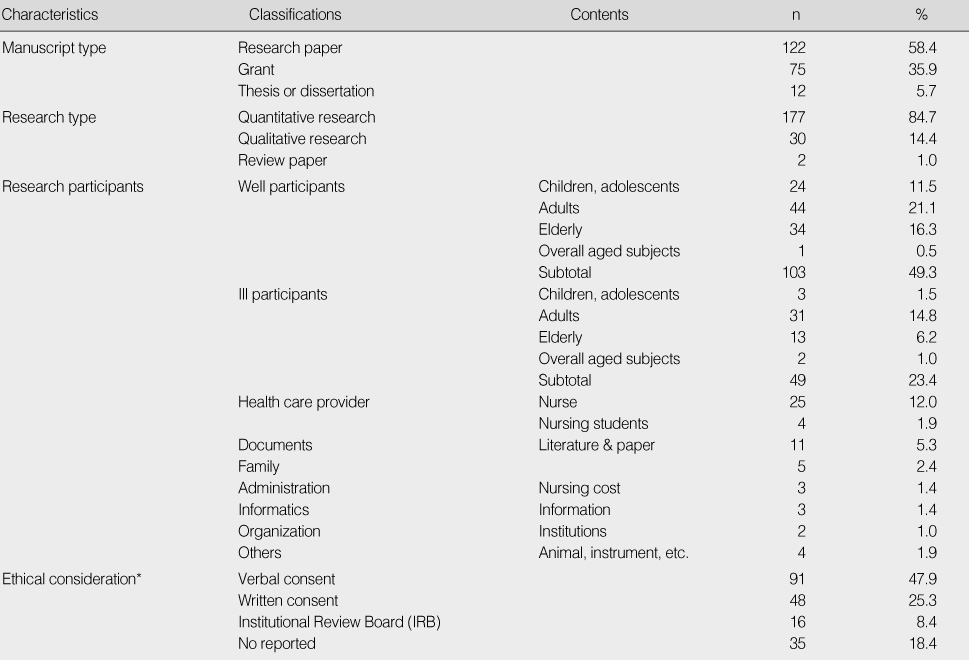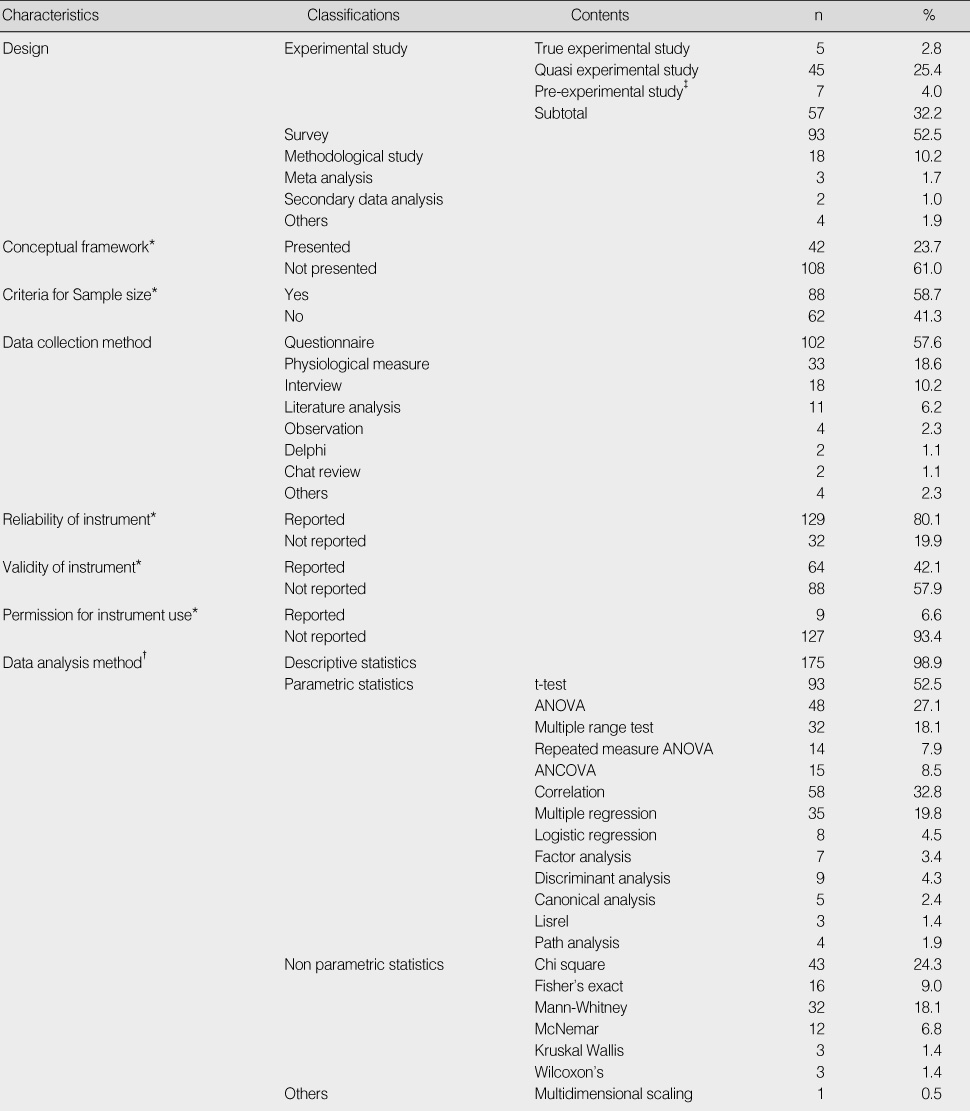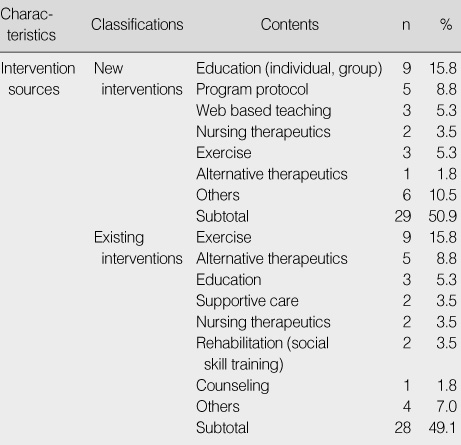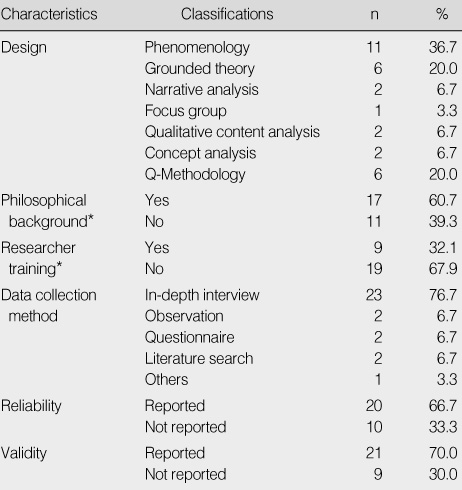Articles
- Page Path
- HOME > J Korean Acad Nurs > Volume 40(1); 2010 > Article
-
Original Article
- Analysis of Research Papers Published in the Journal of the Korean Academy of Nursing-Focused on Research Trends, Intervention Studies, and Level of Evidence in the Research
- Hyun-Sook Shin, Myung-Sun Hyun, Mi-Ok Ku, Myung-Ok Cho, Sook-Young Kim, Jea-Sim Jeong, Geum-Hee Jeong, Gyeong-Ae Seomoon, Youn-Jung Son
-
Journal of Korean Academy of Nursing 2010;40(1):139-149.
DOI: https://doi.org/10.4040/jkan.2010.40.1.139
Published online: February 28, 2010
1College of Nursing Science, East-West Nursing Research Institute, Kyung Hee University, Seoul, Korea.
2College of Nursing, Ajou University, Suwon, Korea.
3College of Nursing, Gyeongsang National University, Jinju, Korea.
4Department of Nursing, Dongeul University, Busan, Korea.
5Division of Nursing, Department of Nursing, College of Health Science, CHA University, Seongnam, Korea.
6Department of Clinical Nursing, Ulsan University, Ulsan, Korea.
7Division of Nursing, Hallym University, Chuncheon, Korea.
8College of Nursing, Korea University, Seoul, Korea.
9Department of Nursing, Soonchunhyang University, Cheonan, Korea.
- Address reprint requests to: Hyun, Myung-Sun. College of Nursing, Ajou University, 5 Woncheon-dong, Yeongtong-gu, Suwon 442-721, Korea. Tel: 82-31-219-7014, Fax: 82-31-219-7020, mhyun@ajou.ac.kr
Copyright © 2010 Korean Society of Nursing Science
Abstract
-
Purpose
- This study aimed was done to analyze recent trends in nursing research published in the Journal of Korean Academy of Nursing by focusing on the content of nursing interventions and their level of evidence.
-
Methods
- A total of 209 studies published between 2007 and 2008 were reviewed using analysis criteria developed by the researchers.
-
Results
- The number of quantitative studies was greater than that of qualitative studies. There was a slight increase in the number of qualitative studies and studies including elderly populations, which reflects the recent population trend in Korea. More randomized controlled trials with a low risk of bias were needed to support more evidence-based nursing practice. Concerning the low rate of ethical consideration, stricter application of research ethics needs to be encouraged.
-
Conclusion
- The findings of this study suggest the recent trends in nursing research and the direction of nursing research and review in the Journal.
- 1. Choi KS, Song MS, Hwang AR, Kim KH, Chung MS, Shin SR, et al. The trend of nursing research in the Journal of the Korean Academy of Nursing. Journal of Korean Academy of Nursing. 2000;30:1207–1218.
- 2. Davies D, Dodd J. Qualitative research and the question of rigor. Qualitative Health Research. 2002;12:279–289.ArticlePubMedPDF
- 3. Dougherty MC, Lin SY, McKenna HP, Seers K. International content of high ranking nursing journals in the year 2000. Journal of Nursing Scholarship. 2004;2:173–179.
- 4. Fawcett J. The state of nursing science: Hallmarks of the 20th and 21st centuries. Nursing Science Quarterly. 1999;12:311–318.ArticlePubMed
- 5. Jang SO. Analysis of research papers published in the Journal of Korean Academy of Nursing by the classification of knowingin nursing. Journal of Korean Academy of Nursing. 2005;35:206–212.PubMed
- 6. Jeong GH, Ahn YM, Cho DS. Coincidence analysis of key words of the Journal of Korean Academy of Nursingwith MeSH. Journal of Korean Academy of Nursing. 2005;35:1420–1425.ArticlePubMedPDF
- 7. Kang HC. Analysis of statistical method applied in the Journal of Korean Academy of Nursing. Journal of Korean Academy of Nursing. 2002;35:929–935.
- 8. Mantzoukas S. A review of evidence-based practice, nursing research and reflection: Levelling the hierarchy. Journal of Clinical Nursing. 2008;17:214–223.ArticlePubMedPDF
- 9. Mantzoukas S. The research evidence published in high impact nursing journals between 2000 and 2006: A quantitative content analysis. International Journal of Nursing Studies. 2009;46:479–489.ArticlePubMed
- 10. McEwen M. McEwen W, Melanie EM. Philosophy, science, and nursing. In: Theoretical basis for nursing. 2007;Philadelphia, PA, Lippincott-Williams and Wilkins. 12–13.
- 11. Morse KM. Reconceptualizing qualitative evidence. Qualitative Health Research. 2006;16:415–422.ArticlePubMedPDF
- 12. Park MH. Understanding and application of Evidence Based Practice. 2006;Seoul, Kunga Publishing Company.
- 13. Park YW, Lee YW, Kim OS, Cho MO. The trends of nursing research in the Journal of Korean Academy of Adult Nursing. Journal of Korean Academy of Adult Nursing. 2008;20:176–186.
- 14. Peterson SJ. Peterson SJ, Bredow TS. Introduction to the nature of nursing knowledge. In: Middle range theories. 2009;Philadelphia, PA, Lippincott-Williams and Wilkins. 35–36.
- 15. Rahm-Hallberg I. Challenges for future nursing research: Providing evidence for health-care practice. International Journal of Nursing Studies. 2006;43:923–927.ArticlePubMed
- 16. Rycroft-Malone J. Theory and knowledge translation: Setting some coordinates. Nursing Research. 2007;56:Suppl. 4. 78–85.
- 17. Seers K. Evaluating complex interventions. Worldviews on Evidence-Based Nursing. 2007;4(2):67–68.ArticlePubMed
- 18. Suh YO, Park JS, Yang JH, Kim HW, Suk MH, Shin HS, et al. Analysis of research papers published in the Journal of Korean Academy of Nursing. Journal of Korean Academy of Nursing. 2007;37:1013–1019.ArticlePubMedPDF
- 19. Wallin L. Knowledge translation and implementation research in nursing. International Journal of Nursing Studies. 2009;46:576–587.ArticlePubMed
- 20. Walker W. The strengths and weaknesses of research designs involving quantitative measures. Journal of Research in Nursing. 2005;10:571–582.ArticlePDF
- 21. Webb C. An analysis of recent publications in JCN: Sources, methods and topics. Journal of Clinical Nursing. 2003;12:931–934.ArticlePubMed
REFERENCES
Figure & Data
REFERENCES
Citations

- A comprehensive analysis of research trends on andropause among middle-aged South Korean men
Young Hwa Lee, Sun Jung Park, Hyun Ji Kim, Bock Soon Park, Hyo Yeol Jang, Ha Na Cho, Young Sook Lim
International Journal of ADVANCED AND APPLIED SCIENCES.2023; 10(6): 129. CrossRef - A Scoping Review of Instruments for Measuring Problem-Solving Ability in Simulation Nursing Education in Korea: A Focus on Process Behavior Survey
Ancho Lim, Youngshin Song
Journal of Korean Academy of Fundamentals of Nursing.2022; 29(3): 269. CrossRef - Analysis of Research Topics and Trends in the Journal of Korean Academy of Nursing to Improve Its International Influence
Soyoung Yu, Jeung-Im Kim, Jin-Hee Park, Sun Joo Jang, Eunyoung E. Suh, Ju-Eun Song, YeoJin Im
Journal of Korean Academy of Nursing.2020; 50(4): 501. CrossRef - Nurse researchers’ perspectives on research ethics in China
Can Gu, Man Ye, Xiaomin Wang, Min Yang, Honghong Wang, Kaveh Khoshnood
Nursing Ethics.2019; 26(3): 798. CrossRef - An Analysis of Research on Parenting Stress of Unmarried Mothers in Korea
Kyung-Sook Bang, Sungjae Kim, Yeseul Jeong, Min Kyung Song, Gumhee Lee, Jihee Lim
STRESS.2019; 27(4): 287. CrossRef - A Literature Review of Research on Leadership of Korean Hospital Nurse
Sunmi Kim, Myoung Hee Seo, Seok Hee Jeong, Hee Sun Kim, Yoon Lee Kim
Journal of Korean Academy of Nursing Administration.2019; 25(5): 404. CrossRef - The Analysis of Research Trends of Elderly in the Dental Hygiene Discipline
Hwa-Soo Goong, Kawoun Seo
Journal of Dental Hygiene Science.2018; 18(4): 201. CrossRef - Trends in Evidence-based Nursing Research in South Korea
Seang Ryu, Sun Weon Yun, Yun Sook Kim
Journal of Korean Academy of Nursing Administration.2017; 23(4): 385. CrossRef - Validity and Reliability of the Korean Version of a Tool to Measure Uncivil Behavior in Clinical Nursing Education
Su Ok Jo, Jina Oh
The Journal of Korean Academic Society of Nursing Education.2016; 22(4): 537. CrossRef - An Analysis of Research Studies Published in the Journal of Korean Academy of Psychiatric and Mental Health Nursing (JKPMHN) based on Knowledge Development Classifications of Nursing: Publication Articles from 2010 to 2014
Ji-Hye Kim, Seog-Bun Yoo
Journal of Korean Academy of Psychiatric and Mental Health Nursing.2016; 25(1): 21. CrossRef - Analysis of Research Papers Published in the Journal of Muscle and Joint Health on Research Trends, Nursing Intervention and Quality Assessment of Intervention Studies
Mi Yang Jeon, Young Eun, Eun Nam Lee, Hye Sook Min, Won-Sook Bak, Mi-Kyung Choi, Rhayun Song, Inok Lee, Hee Kwon Choi, Gyeyoung Shin, Minju Kim, Kyung-Sook Lee, Myung Sook Lee, Kyung-Sook Cho, Ju Sung Kim, Yeo Sook Chung
Journal of muscle and joint health.2016; 23(3): 214. CrossRef - Health Status Assessment Tool Development based on Dietary Patterns in Middle-Aged Women
Hye-Jin Lee, Kyung-Hea Lee
Korean Journal of Community Nutrition.2016; 21(1): 37. CrossRef - Analysis of Studies on High-Risk Infants and Quality Assessment of Intervention Studies
Hyejung Lee, Anna Kim, Anna Maeng, Gayeong Kim
Child Health Nursing Research.2016; 22(2): 153. CrossRef - Trends in Nursing Research on Cancer Patients Nutrition in Korea
Su-Ol Kim
Asian Oncology Nursing.2016; 16(1): 1. CrossRef - Knowledge regarding Cervical Cancer, Human Papillomavirus (HPV) and Intention for Vaccination among the Personnel in Korean Military Service*
Hyunkyung Shin, Hyojung Park
Journal of Korean Academy of Fundamentals of Nursing.2015; 22(2): 158. CrossRef - Comparison of Domestic and International Research (1992-2011): Intensive Care Nursing Studies
Eun Hee Choi, Eun Hee Jang, Ji Youn Choi, So Jung Lee, Hyo Kuyng Seo, Kyung Sook Park
Korean Journal of Adult Nursing.2015; 27(4): 384. CrossRef - Trends of Studies Published in Asian Oncology Nursing, 2011~2014
Soo Hyun Kim, Min Young Kim, Sun-Hee Kim, Hye Kyung Kim, Insook Lee, Jiyeon Lee, Yun Hee Ham, Eunjung Ryu
Asian Oncology Nursing.2015; 15(2): 114. CrossRef - Trend Analysis of Research in the Korean Journal of Adult Nursing for 5 Years (2010~2014): Focused on Usage of Nursing Theories
Nam Kyung Han, Sanghee Kim, Myoung Shin Kim, Jong Gun Kim, Chang Hwan Kim, Seung Hye Choi
Korean Journal of Adult Nursing.2015; 27(5): 527. CrossRef - Use of Animals for Nursing Research in Korea
Hae Young Yoo
Journal of Korean Biological Nursing Science.2015; 17(4): 324. CrossRef - Knowledge Structure of the Korean Journal of Occupational Health Nursing through Network Analysis
Sun Young Kwon, Eun Jung Park
Korean Journal of Occupational Health Nursing.2015; 24(2): 76. CrossRef - A quality evaluation of nursing intervention studies in Mainland China: From 1979 to 2012
Wei-Jie Xing, Liang Fu, Meng-Xue He, Yan Hu, Jun Ying
International Journal of Nursing Sciences.2014; 1(2): 145. CrossRef - An Integrative Review of Infection Control Research in Korean Nursing Journals
Kyung Mi Kim, Jeong Sil Choi
Asian Nursing Research.2014; 8(2): 128. CrossRef - Trends in Nursing Research in Korea: Research Trends for Studies Published from the Inaugural Issue to 2010 in the Journal of Korean Academy of Nursing and the Journals Published by Member Societies under Korean Academy of Nursing Science
Myoung-Ae Choe, Nam Cho Kim, Kyung Mi Kim, Sung Jae Kim, Kyung Sook Park, Young Soon Byeon, Sung Rae Shin, Soo Yang, Kyung Sook Lee, Eun Hyun Lee, In Sook Lee, Tae Wha Lee, Myung Ok Cho, Jin Hak Kim
Journal of Korean Academy of Nursing.2014; 44(5): 484. CrossRef - Trend Analysis of Experimental Research Papers on Community Health Nursing: Based on Researches Published in the Journal of Korean Academy of Community Health Nursing, 1989~2012
Chunmi Kim, Seung Joo Lim
Journal of Korean Academy of Community Health Nursing.2014; 25(2): 146. CrossRef - Trend Analysis of Articles Published in the Journal of East-West Nursing Research
Hyun Ji Kim, Hanna Lee, Hyun Su Oh, Yu Jeong Yang, Sung Hee Shin
Journal of East-West Nursing Research.2014; 20(2): 167. CrossRef - Quality Assessment of Non-Randomized Studies in the Journal of Korean Fundamentals of Nursing
Jongsoon Won, YunHee Shin, HyoungSook Park, Hyojung Park, Se Hyun Lim, Mee-Kyung Shin, Young-Ok Yang, Young-Ju Kim, Sung Ok Chang, Seung Kyo Chaung, Jung-Hee Kim
Journal of Korean Academy of Fundamentals of Nursing.2014; 21(3): 311. CrossRef - An Analysis of Nursing Research on Child Rearing in Korea.
Dong Won Lee, In Soo Kwon
Child Health Nursing Research.2014; 20(4): 264. CrossRef - A Guide on the Use of Factor Analysis in the Assessment of Construct Validity
Hyuncheol Kang
Journal of Korean Academy of Nursing.2013; 43(5): 587. CrossRef - Problems and Prospects of Nursing Research on Job Stress in Korea
Wonsup Cho, Myoungsoon You
Journal of Korean Academy of Nursing Administration.2013; 19(1): 63. CrossRef - The Analysis of Research Trend on Pediatric Nursing Intervention Studies in Korea, 2000-2011
Kyung-Sook Bang, Hyunju Kang, Miyoung Kim, Sujung Min, Sujin Lee, Haein Lee, Jihee Lim
The Journal of Korean Academic Society of Nursing Education.2013; 19(1): 24. CrossRef - Analysis of Research Articles Published in the Journal of Korean Academy of Nursing Administration for 3 Years (2010~2012)
Keum Seong Jang, Bok Nam Kim, Yun Min Kim, Jung Sook Kim, Seok Hee Jeong
Journal of Korean Academy of Nursing Administration.2013; 19(5): 679. CrossRef - Measurement Properties of Self-report Questionnaires Published in Korean Nursing Journals
Eun-Hyun Lee, Chun-Ja Kim, Eun Jung Kim, Hyun-Ju Chae, Soo-Yeon Cho
Journal of Korean Academy of Nursing.2013; 43(1): 50. CrossRef - Current Status and Challenges of Research Methology for Health Promotion Research: Focusing on Research Funded by the Korea Health Promotion Foundation, 2005-2011
Ji-Young An, Kwang Kee Kim, Jung JeKarl, Hyunjung Moon, Sun Kyung Cha, Eunha Jeong
Korean Journal of Health Education and Promotion.2013; 30(5): 47. CrossRef - Trends in Research on Caregivers Hospitalized Children in Korea-Focus on Knowledge Type
In-soo Kwon, Yeong-mi Seo, Ji-youn Kim
Journal of Korean Academy of Child Health Nursing.2012; 18(3): 101. CrossRef - Analysis of Trends and Contents of Nursing Doctoral Dissertations in Korea
Kwang-Ja Lee, Younhee Kang, Mee Ock Gu, Kyunghee Kim, Oksoo Kim, Yeon-Ok Suh, Eunyoung Suh, Soo Yang, Eun-Hyun Lee, Ja Hyung Lee, Myoung-Ae Choe, Yang Sook Hah
Journal of Korean Academy of Nursing.2012; 42(2): 302. CrossRef - Quality assessment of systematic reviews or meta-analyses of nursing interventions conducted by Korean reviewers
Hyun-Ju Seo, Kyeong Uoon Kim
BMC Medical Research Methodology.2012;[Epub] CrossRef - Analysis of Quantitative Research Published by Korean Journal of Adult Nursing (1989~2011)
Young-Kyeong Kim, Sun-Kyung Hwang, In-Ja Kim, Ju-Sung Kim, Hee-Young Oh, Jong-Kyung Lee, Eun-Sook Jung, Gui-Yun Choi, Ja-Yun Choi
Korean Journal of Adult Nursing.2012; 24(1): 85. CrossRef - Trends in Research Studies Published in Journal of Korean Academy of Fundamentals of Nursing: 2009-2011
Kyung-Hee Kim, Sung-Ok Chang, Hyun-Sook Kang, Keum-Soon Kim, Jong-Im Kim, Hwa-Soon Kim, Jin-Hee Park, Mi-Ran Eom, Jong-Soon Won, Mi-Sun Youn, Og-Cheol Lee
Journal of Korean Academy of Fundamentals of Nursing.2012; 19(3): 383. CrossRef - Analysis of Research Trends in Papers Published in the Journal of Korean Academy of Child Health Nursing (2005-2009)
Jin-Sun Kim, Ji-Young Lim, In-Soo Kwon, Tae-Im Kim, Ho-Ran Park, Hae-Young Ahn, Soo-Yeon Lee, Hyang-Mi Jung
Journal of Korean Academy of Child Health Nursing.2011; 17(2): 100. CrossRef - Analysis on Reports of Statistical Testing for Mean Differences in Articles in the Korean Journal of Women Health Nursing
Eun-Mi Jun, Eun-Hee Lee, Jeung-Im Kim, Hee Sun Kang, Hyun Ei Oh, Eun-Joo Lee, Suk-Hee Cheon
Korean Journal of Women Health Nursing.2011; 17(4): 388. CrossRef - Analysis of Research Papers Published by Three Nursing Journals to Suggest the Direction of Journal of Korean Oncology Nursing
Myunghee Jun, Hyang Sook So, Kyung Sook Choi, Bok Yae Chung, Eunjung Ryu, Dong-Suk Lee, Jeong Hee Kang
Journal of Korean Oncology Nursing.2011; 11(2): 163. CrossRef - Analysis of Experimental Research Trends on Doctoral Dissertations in Nursing
Heun-Keung Yoon, Hee-Soon Kim, Hyun-Jung Yun
The Journal of Korean Academic Society of Nursing Education.2011; 17(3): 464. CrossRef - Analysis of the Correlation and Regression Analysis Studies from the Korean Journal of Women Health Nursing over the Past Three Years (2007~2009)
Eun-Joo Lee, Eun-Hee Lee, Jeung-Im Kim, Hee Sun Kang, Hyun Ei Oh, Eun Mi Jun, Suk-Hee Cheon
Korean Journal of Women Health Nursing.2011; 17(2): 187. CrossRef - A Social Network Analysis of Research Topics in Korean Nursing Science
Soo-Kyoung Lee, Senator Jeong, Hong-Gee Kim, Young-Hee Yom
Journal of Korean Academy of Nursing.2011; 41(5): 623. CrossRef - Analysis of Published Papers by Keywords and Research Methods in the Korean Journal of Women Health Nursing (2007~2009)
Jeung-Im Kim, Eun-Hee Lee, Hee Sun Kang, Hyun-Ei Oh, Eun-Joo Lee, Eun-Mi Jun, Suk-Hee Cheon
Korean Journal of Women Health Nursing.2010; 16(3): 307. CrossRef - Analysis of the Journal of Korean Academy of Nursing Administration for 3 Years (2007-2009)
Jong Kyung Kim, Myun Sook Jung, Keum Seong Jang, Jinhyun Kim, Eun-Kyung Kim, Haejung Lee, Young Mee Kim, Se Young Kim, Eun Jun Park
Journal of Korean Academy of Nursing Administration.2010; 16(4): 517. CrossRef
Overall Analysis of Published Papers (N=209)
*Non applicable cases excluded.
Characteristics of Quantitative Research (N=177)
*Non applicable cases excluded; †Multiple responses; ‡Single group pre-post test.
Analysis of Intervention Studies (N=57)
Analysis of Qualitative Research (N=30)
*Non applicable cases excluded.
Level of Evidence of Research (N=209)
*Non applicable cases excluded.
*Non applicable cases excluded; †Multiple responses; ‡Single group pre-post test.
*Non applicable cases excluded.
 KSNS
KSNS
 E-SUBMISSION
E-SUBMISSION





 Cite
Cite

